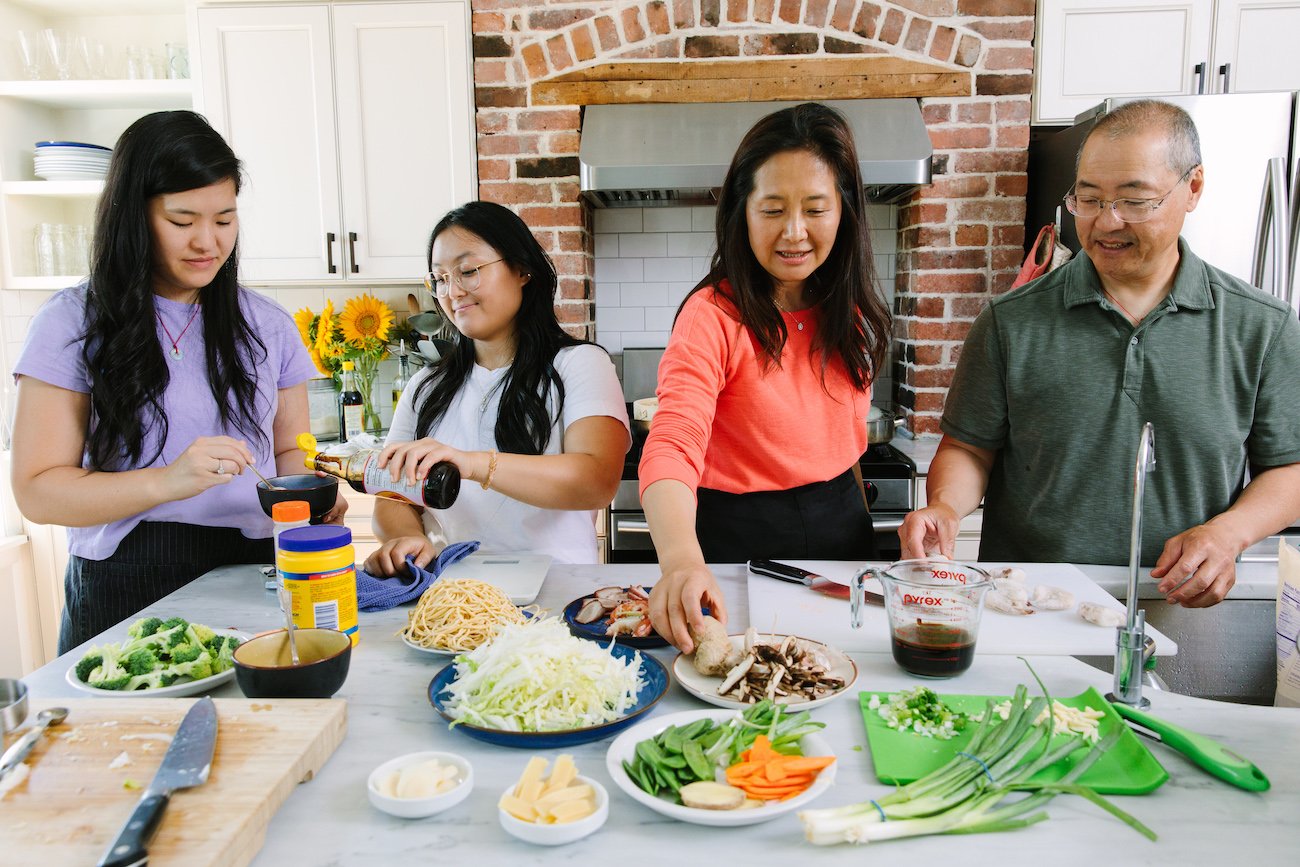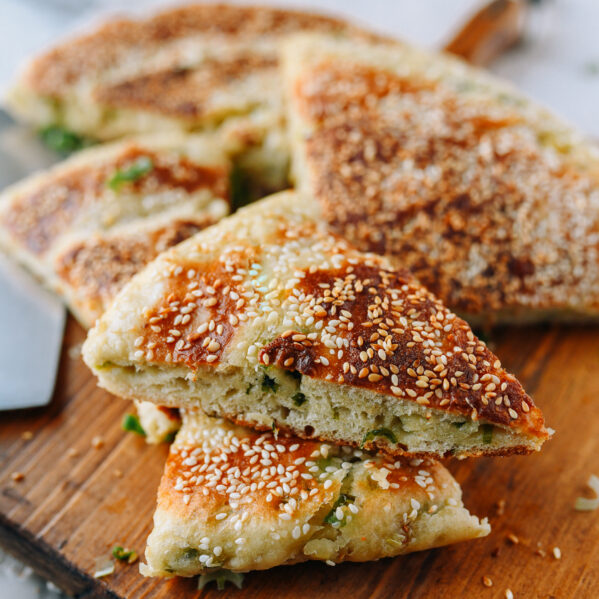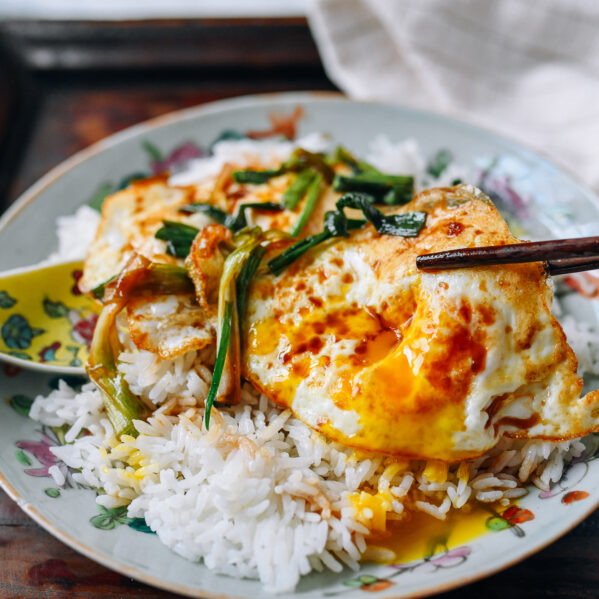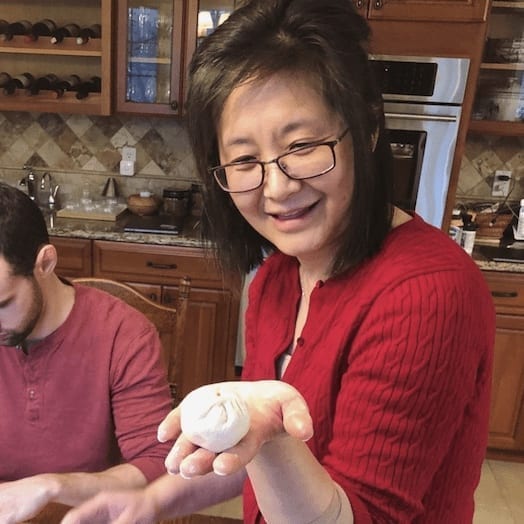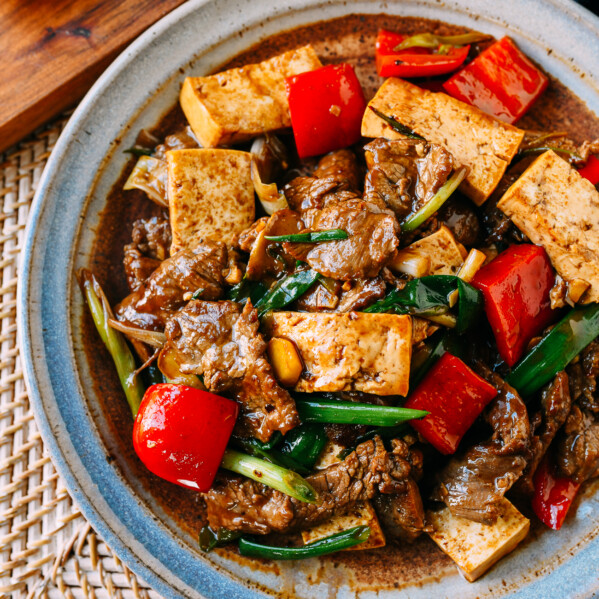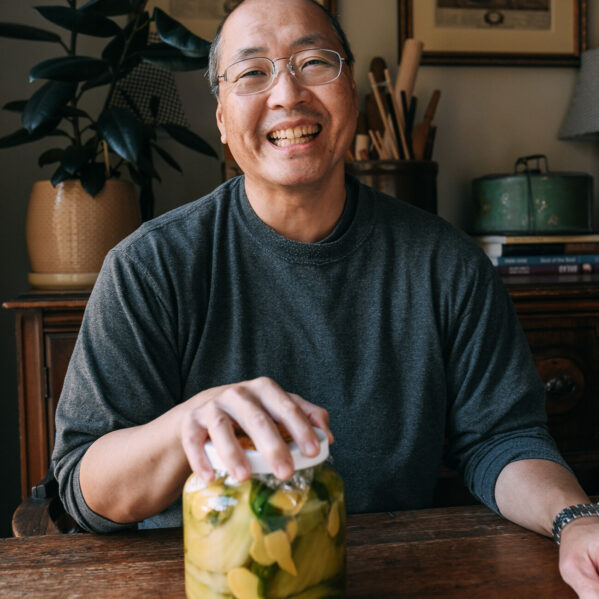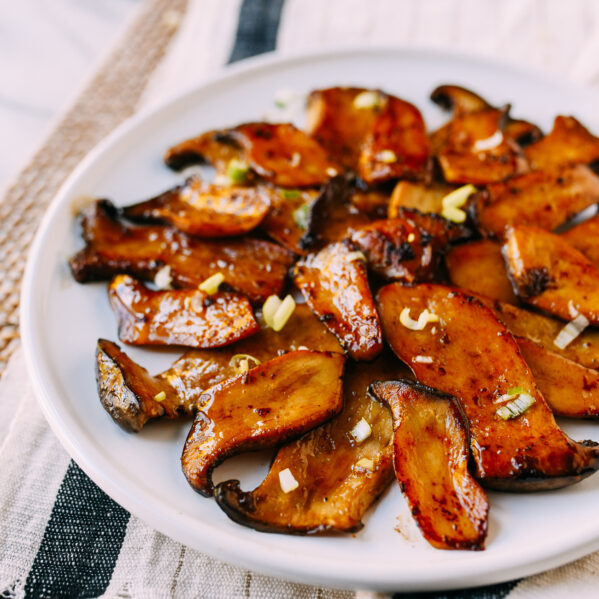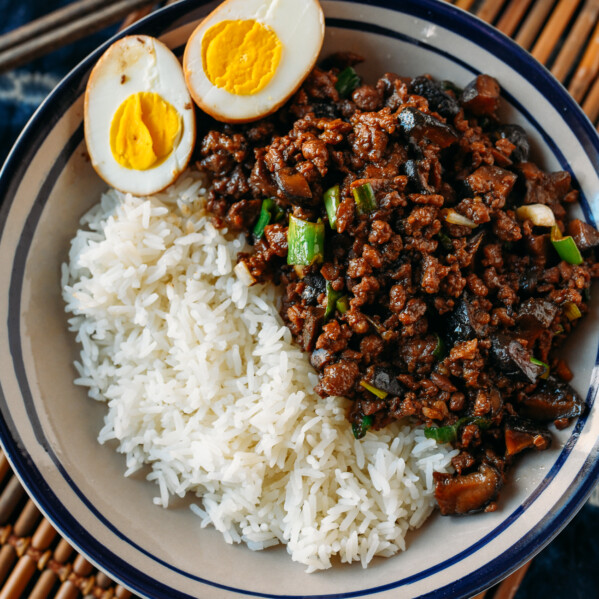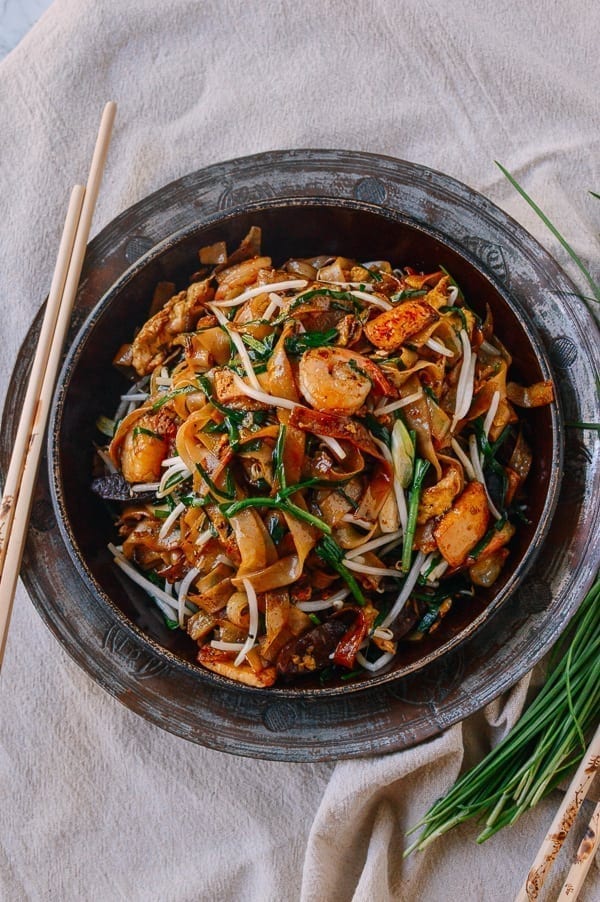
2 Most Important Elements: Carbon Steel Wok & High Heat
If you have a well stocked Chinese pantry or can get the specialty ingredients and spices for this dish, then you are on your way to Char Kway Teow heaven. This dish is tricky to get right with omissions and substitutions, but the most important factors to making an authentic Char Kway Teow are probably the carbon steel wok and high heat. While Asian street food chefs might not have the benefit of a full kitchen, the constant is always a solid cooking vessel and plenty of roaring heat. Just check out some of the photos from our trip to Xi’an, where we sampled plenty of street food, and you’ll get the picture.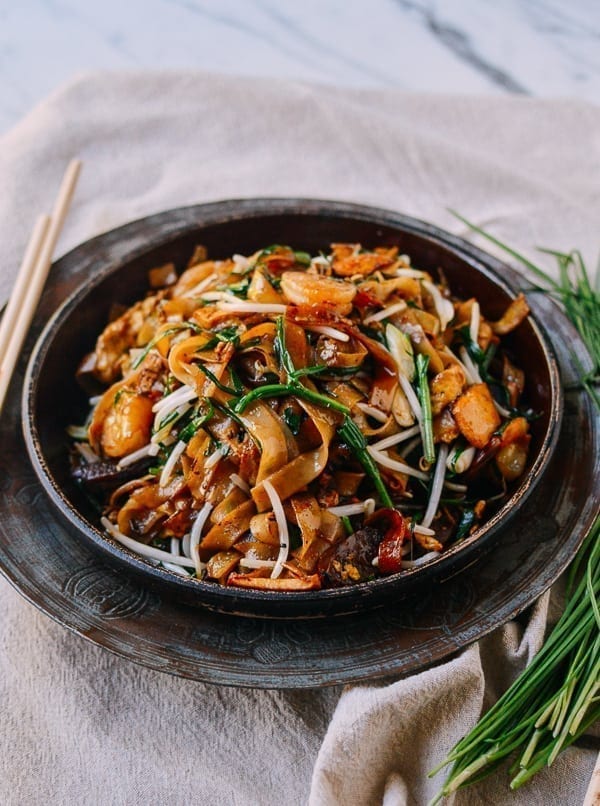 A large carbon steel wok provides a larger surface area that can be superheated to sear and char the noodles, creating that wok hei flavor. If you don’t have a wok yet, check out our post on the Best Wok to Buy to choose the right one for you. If you already own a carbon steel wok, be sure to check our post on How to Season and Care for your Carbon Steel Wok.
If you like the looks of this rice noodle dish, give our Shrimp Pad Thai, Pad Kee Mao, or Pad See Ew recipes a try!
A large carbon steel wok provides a larger surface area that can be superheated to sear and char the noodles, creating that wok hei flavor. If you don’t have a wok yet, check out our post on the Best Wok to Buy to choose the right one for you. If you already own a carbon steel wok, be sure to check our post on How to Season and Care for your Carbon Steel Wok.
If you like the looks of this rice noodle dish, give our Shrimp Pad Thai, Pad Kee Mao, or Pad See Ew recipes a try!
Char Kway Teow Cooking Tips
Before we start, some quick tips on cooking this Char Kway Teow:- For most folks with smaller woks (ours is enormous), it’s best to divide the ingredients in half and cook this dish in two batches. Street vendors usually cook dishes one serving at a time to keep the wok super hot, ensuring that wok hei flavor and making the dish easier to handle.
- Have everything prepared in advance, because with the high heat, you’ll have to move very quickly so you don’t burn your dish. Char is good, burn is bad.
- Be gentle with those rice noodles, especially if they are fresh, because they break easily. Dried flat rice noodles are sturdier and easier to find in Asian grocery stores.
- Fish sauce and shrimp sauce or shrimp paste are the flavors that make this dish what it is, but they’re quite salty, so follow the directions closely for the first batch and feel free to adjust to taste for the second batch.
- Serve your Char Kway Teow with garlic chili sauce or hot chili oil on the side. Some recipes add the chili to the dish, and it creates a uniform spicy burn. You can do either!
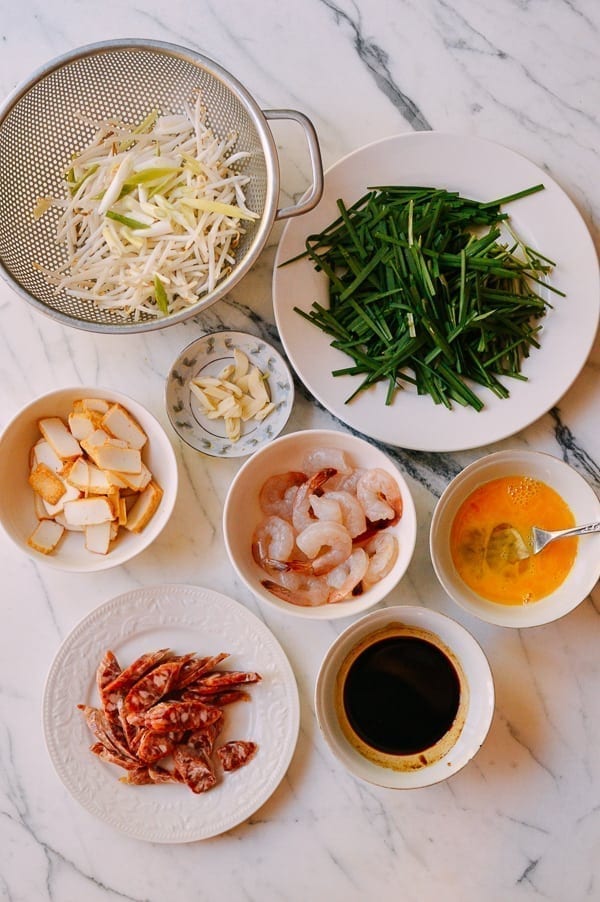 Okay, go get your wok out, and let’s do this!
Okay, go get your wok out, and let’s do this!
Char Kway Teow Recipe Instructions
Soak the dried noodles in warm water for 30 to 45 minutes. Transfer to a colander and let the excess water drain. If you have fresh rice noodles, cut them into 1½-inch wide strips, and set them aside. You can even try making your own rice noodles at home using Judy’s recipe for Homemade Rice Noodles.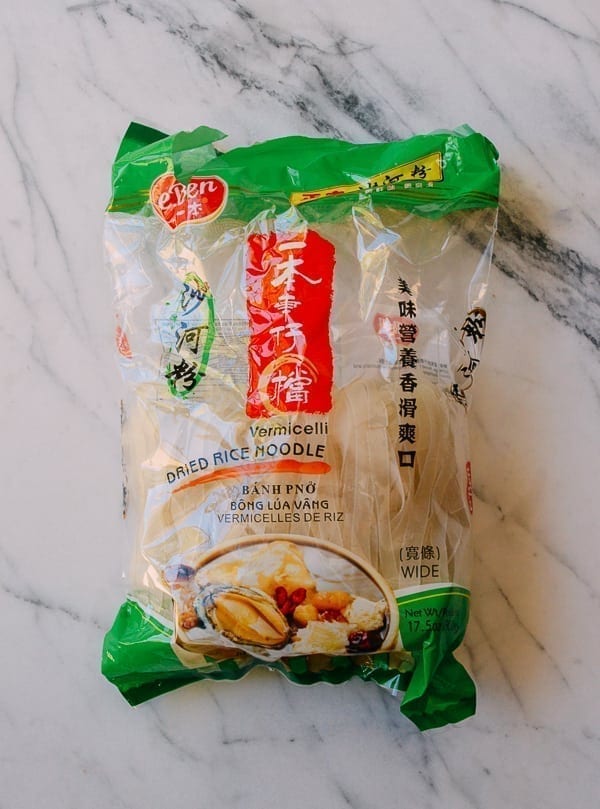
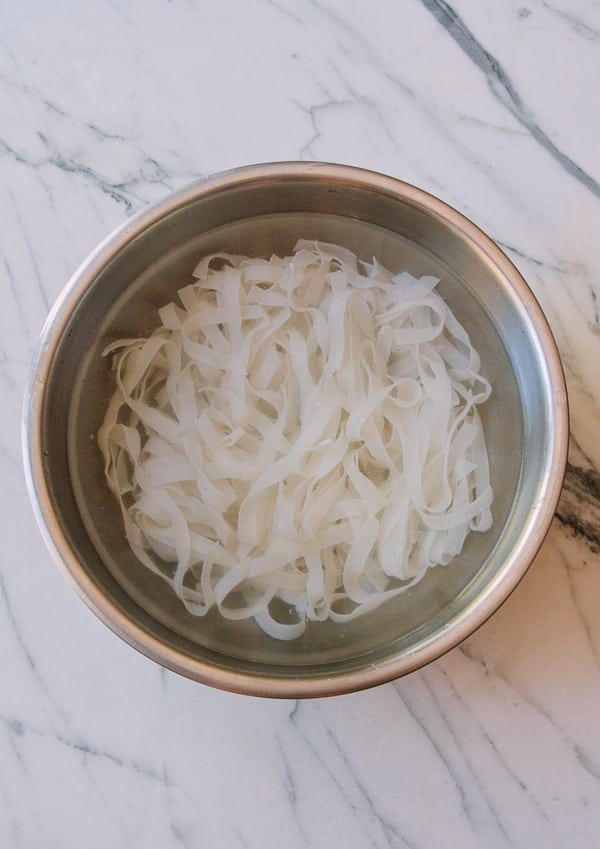 Add 2 teaspoons dark soy sauce, 2 tablespoons regular soy sauce, 1 tablespoon fish sauce, 1 teaspoon shrimp sauce or shrimp paste, 1 tablespoon oyster sauce, ⅛ teaspoon ground white pepper, and 1 teaspoon sugar in a small bowl. Mix until combined, and set aside.
Heat your wok to medium heat, and spread 1 tablespoon of vegetable oil around the perimeter of your wok. Add the sliced Chinese sausages and stir-fry for 20 seconds. Add the garlic.
Add 2 teaspoons dark soy sauce, 2 tablespoons regular soy sauce, 1 tablespoon fish sauce, 1 teaspoon shrimp sauce or shrimp paste, 1 tablespoon oyster sauce, ⅛ teaspoon ground white pepper, and 1 teaspoon sugar in a small bowl. Mix until combined, and set aside.
Heat your wok to medium heat, and spread 1 tablespoon of vegetable oil around the perimeter of your wok. Add the sliced Chinese sausages and stir-fry for 20 seconds. Add the garlic.
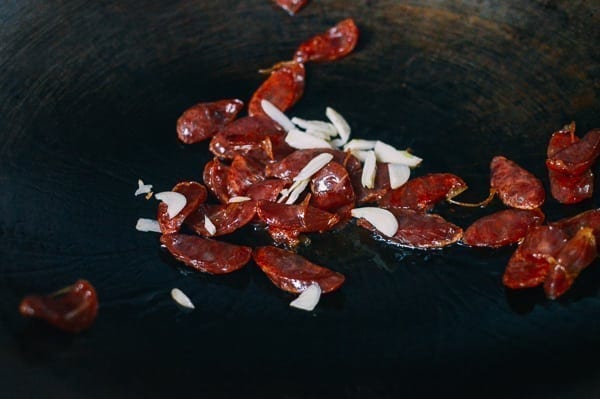 Along with the shrimp…
Along with the shrimp…
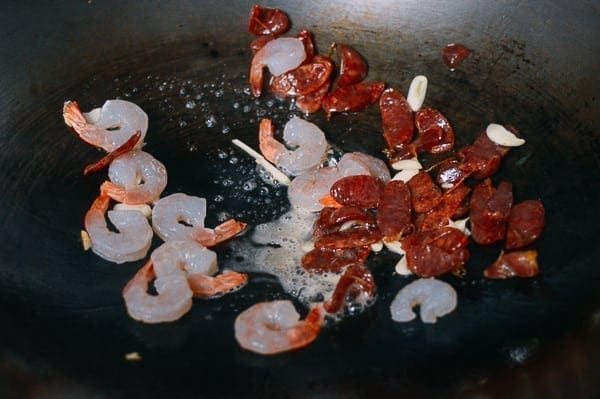 And the fish tofu. Continue stir-frying for another 20 seconds.
And the fish tofu. Continue stir-frying for another 20 seconds.
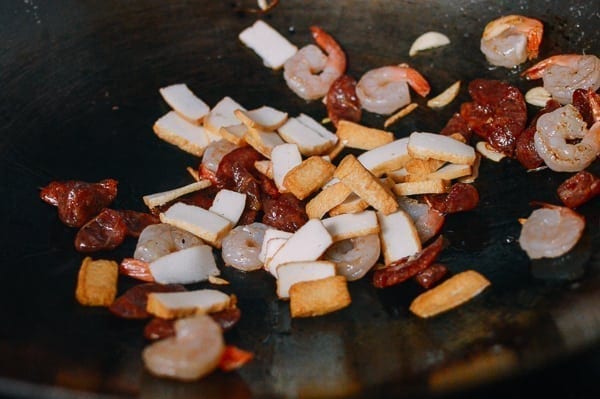 Now, turn the wok to high heat. Spread 1 tablespoon shaoxing wine around the perimeter of the wok.
Stir-fry for another 15 seconds. Add the noodles. Gently fold them into the rest of the ingredients. Gather everything in the middle of the wok to let the sides of the wok superheat. Pour the sauce mixture evenly over the noodles, and spread another tablespoon of vegetable oil around the perimeter of the wok.
Now, turn the wok to high heat. Spread 1 tablespoon shaoxing wine around the perimeter of the wok.
Stir-fry for another 15 seconds. Add the noodles. Gently fold them into the rest of the ingredients. Gather everything in the middle of the wok to let the sides of the wok superheat. Pour the sauce mixture evenly over the noodles, and spread another tablespoon of vegetable oil around the perimeter of the wok.
 Next, add the garlic chives.
Next, add the garlic chives.
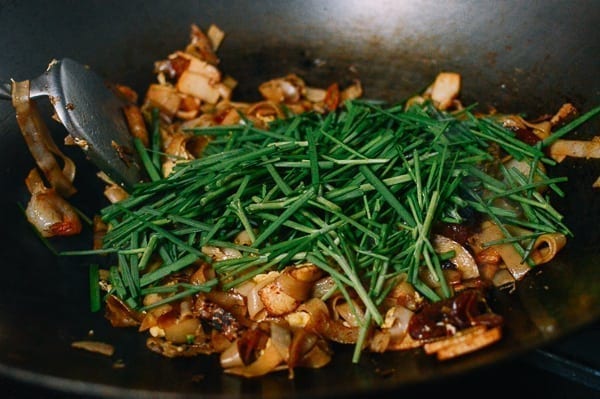 Gently mix the rice noodles (to minimize breakage) while spreading them around the perimeter of the wok to get that wok hay sear from the superheated sides of the wok. Because of the hot wok and the oil, the rice noodles shouldn’t stick.
While the noodles are searing, work quickly to create a space at the bottom of the wok and add the last tablespoon of oil with the slightly beaten egg. Stir the egg around for 15 seconds to cook it and break it up. You may want to pre-cook the egg the first time if you are more of a beginner cook!
Gently mix the rice noodles (to minimize breakage) while spreading them around the perimeter of the wok to get that wok hay sear from the superheated sides of the wok. Because of the hot wok and the oil, the rice noodles shouldn’t stick.
While the noodles are searing, work quickly to create a space at the bottom of the wok and add the last tablespoon of oil with the slightly beaten egg. Stir the egg around for 15 seconds to cook it and break it up. You may want to pre-cook the egg the first time if you are more of a beginner cook!
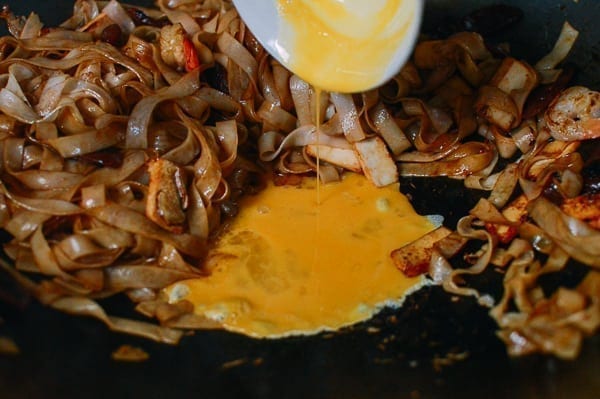
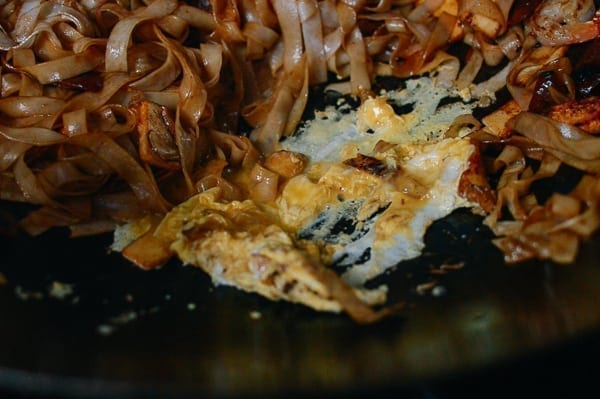 Next add the mung bean sprouts and gently mix everything together for 1 minute.
Next add the mung bean sprouts and gently mix everything together for 1 minute.
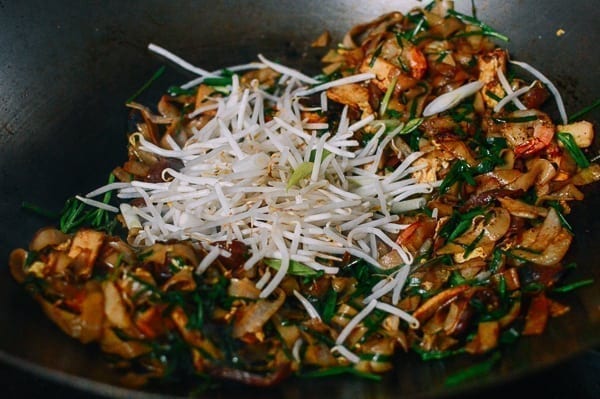 If your Char Kway Teow looks dry, sprinkle 2 tablespoons of water over the noodles while stir-frying. You can also add a bit more vegetable oil if you like. The street hawkers in Southeast Asia often add more oil or pork fat right before they plate it!
If your Char Kway Teow looks dry, sprinkle 2 tablespoons of water over the noodles while stir-frying. You can also add a bit more vegetable oil if you like. The street hawkers in Southeast Asia often add more oil or pork fat right before they plate it!
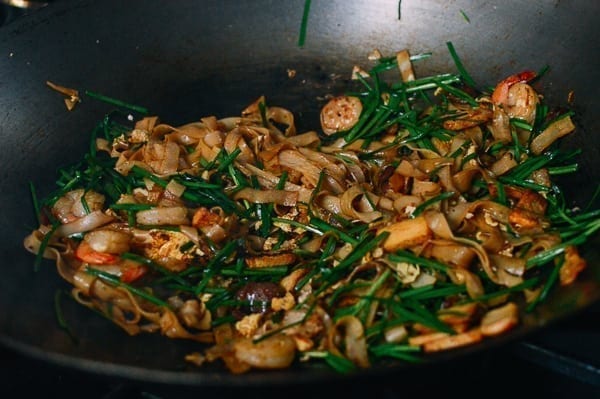 Serve your Char Kway teow with chili garlic paste or homemade chili oil on the side.
Serve your Char Kway teow with chili garlic paste or homemade chili oil on the side.
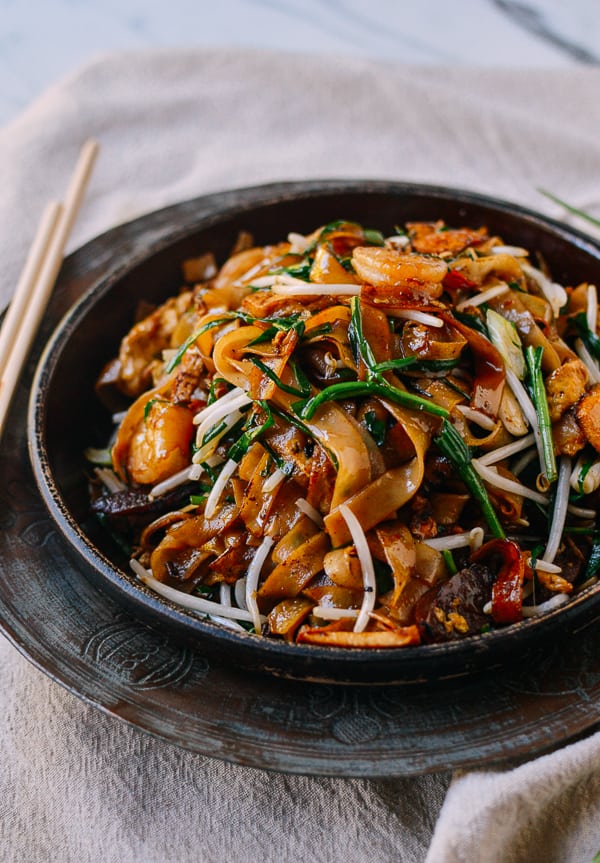
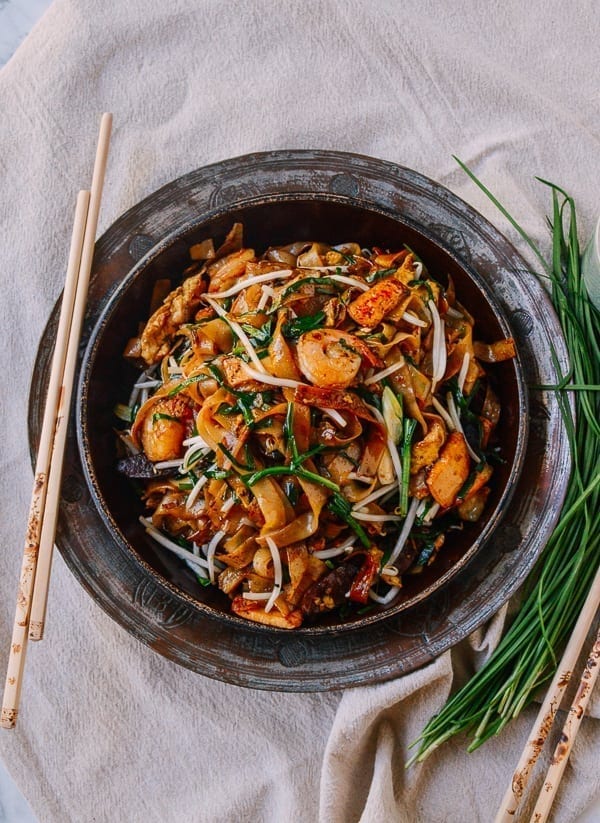
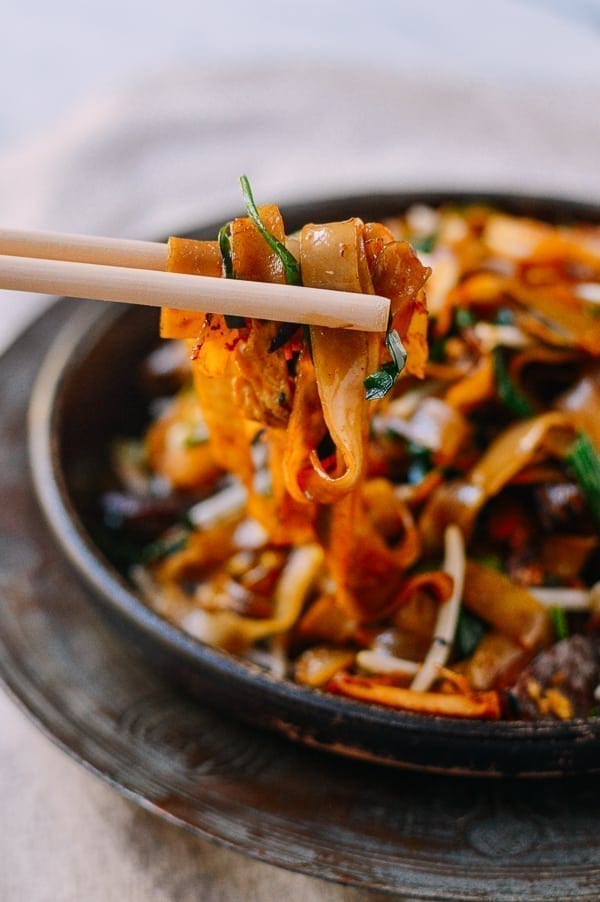
Recipe
Char Kway Teow Malaysian Rice Noodle Stir-fry
Char Kway Teow is a classic rice noodle dish from Malaysia. Wok hay flavor, charred rice noodles and unique ingredients make this Char Kway Teow a must-try!
Serves: 6
Ingredients
- 8 ounces dried wide rice noodles or 1 pound fresh rice noodles (225g dried or 450g fresh)
- 2 teaspoons dark soy sauce
- 2 tablespoons regular soy sauce
- 1 tablespoon fish sauce
- 1 teaspoon shrimp paste or shrimp sauce
- 1 tablespoon oyster sauce
- ⅛ teaspoon white pepper
- 1 teaspoon sugar
- 3 tablespoons vegetable oil (divided)
- 2 Chinese sausages (about 115g, sliced ⅛ inch thick)
- 2 cloves garlic (sliced)
- 4 ounces shrimp (115g, 31 to 40 size)
- 4 ounces fish cake or fish tofu, thinly sliced (115g)
- 4 ounces garlic chives (115g, cut into 2 ½-inch pieces)
- 1 tablespoon shaoxing wine (optional)
- 1 egg (lightly beaten)
- 6 ounces mung bean sprouts (170g)
Instructions
- Soak the dried noodles in warm water for 30 to 45 minutes. Transfer to a colander and let the excess water drain. If you have fresh rice noodles, cut them into 1½-inch wide strips, and set them aside. You can even try making your own rice noodles at home using Judy’s recipe for Homemade Rice Noodles.
- Add 2 teaspoons dark soy sauce, 2 tablespoons regular soy sauce, 1 tablespoon fish sauce, 1 teaspoon shrimp paste, 1 tablespoon oyster sauce, ⅛ teaspoon ground white pepper, and 1 teaspoon sugar in a small bowl. Mix until combined, and set aside.
- Heat your wok to medium heat, and spread 1 tablespoon of vegetable oil around the perimeter of your wok. Add the sliced Chinese sausages and stir-fry for 20 seconds.
- Add the 2 cloves of sliced garlic, the shrimp, and the fish tofu. Continue stir-frying for another 20 seconds.
- Now, turn the wok to high heat. Spread 1 tablespoon shaoxing wine around the perimeter of the wok.
- Stir-fry for another 15 seconds. Add the noodles. Gently fold them into the rest of the ingredients. Gather everything in the middle of the wok to let the sides of the wok superheat. Pour the sauce mixture evenly over the noodles, and spread another tablespoon of vegetable oil around the perimeter of the wok.
- Next, add the garlic chives. Gently mix the noodles (to minimize breakage) while spreading them around the perimeter of the wok to get that wok hay sear from the superheated sides of the wok. Because of the hot wok and the oil, the rice noodles shouldn’t stick.
- While the noodles are searing, work quickly to create a space at the bottom of the wok and add the last tablespoon of oil with the slightly beaten egg. Stir the egg around for 15 seconds to cook it and break it up. You may want to pre-cook the egg the first time if you are more of a beginner cook!
- Next add the mung bean sprouts and gently mix everything together for 1 minute.
- If your Char Kway Teow looks dry, sprinkle 2 tablespoons of water over the noodles while stir-frying. You can also add a bit more vegetable oil if you like. Serve your Char Kway teow with chlli garlic paste or homemade chili oil on the side.
Nutrition Facts
Calories: 374kcal (19%) Carbohydrates: 36g (12%) Protein: 15g (30%) Fat: 18g (28%) Saturated Fat: 9g (45%) Cholesterol: 112mg (37%) Sodium: 993mg (41%) Potassium: 250mg (7%) Fiber: 2g (8%) Sugar: 2g (2%) Vitamin A: 890IU (18%) Vitamin C: 16.1mg (20%) Calcium: 68mg (7%) Iron: 2mg (11%)





